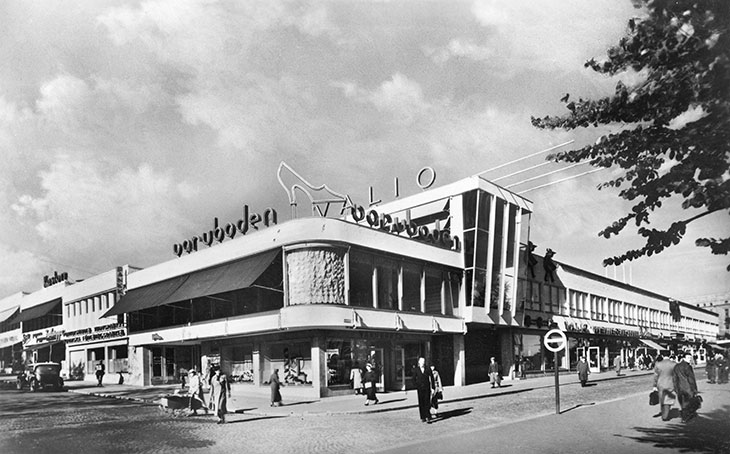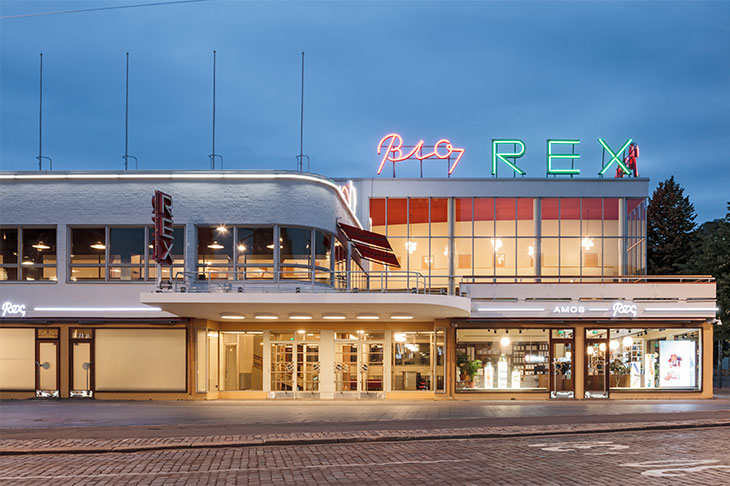In the summer of 1940, Helsinki was supposed to host the Summer Olympics. Two years earlier Tokyo, which had been due to stage the event, had forfeited it following the outbreak of the Second Sino-Japanese War. Helsinki stepped in, and embarked on a city-wide programme of development in preparation for the Games (which did come to the Finnish capital, but not until 1952, after making a post-war comeback in London). The 1940 Olympics may never have happened but their architectural legacy endures: the white, cubic concrete structures of purpose-built sports centres, service buildings and residential areas stand today as classic examples of Finnish functionalism.
The Lasipalatsi (Glass Palace) in Helsinki in 1937. Courtesy Helsingin Kaupungin Museo; © Aarne Pietinen

Located in the city centre, the Lasipalatsi (Glass Palace) – designed by three architecture students and intended as a temporary building for visitor services, which no-one ever got round to demolishing – is widely considered the best of the lot. Over the years the complex served various civic, retail and entertainment uses, but it also fell into disrepair, only partly mitigated by a renovation project in the 1990s. So the city authorities were delighted when a few years ago they were approached by the the Föreningen Konstsamfundet, a private association, which offered to buy a large portion of the building. The association was looking for a new home for the museum named after its founder, the newspaper publisher and arts patron Amos Anderson, which after Anderson’s death in 1961 was set up in the building where he’d lived and worked. Recently, though, it had become apparent that the museum had outgrown that space. The Amos Rex, rebranded after the Bio Rex cinema – a fixture of the Lasipalatsi since its arrival in the 1930s – opened this week after a five-year construction project that has cost €50 million.
The Amos Rex museum in Helsinki. © Tuomas Uusheimo

Speaking at the opening of the museum, its director Kai Kartio spoke of how he came to an awkward realisation early on in the project: the Lasipalatsi itself, with its expanses of glass walls and interiors filled with striking architectural features, could not practically be converted into a light- and climate-controlled art gallery. Another obstacle presented itself: the Helsinki city plan would not allow for an overground extension to be built on the site. The solution, as executed by the Finnish architecture firm JKMM, was to refurbish the 1930s building in its existing capacity as a retail and entertainment space (the Bio Rex cinema will continue to screen art-house films as well as serving as a venue for seminars) while going underground for the museum itself, digging down into the courtyard at the centre of the complex to create a 2,200-square-metre suite of galleries. From ground level, the only visible marker of the new museum is a series of concrete domes, covered in tessellating grey and light orange tiles and punctuated with large circular skylights.
To describe the result as a compromise is by no means to denigrate its achievements. The domes and skylights, if somewhat reminiscent of Teletubbyland, are an effective strategy for making the underground bunker a feature in the city’s urban landscape – and allowing museum visitors a glimpse of the outside world. The purpose-built galleries – simple white spaces with as few load-bearing walls as possible – are similarly fit for purpose: flexible, high-tech and unobtrusive, they can be completely reconfigured according to the art chosen for display.
This adaptability is clearly demonstrated in the museum’s inaugural exhibition, devoted to the Japanese collective teamLab, who operate on the cutting edge of technology to create their high-octane, nature-inspired digital installations. The galleries have been transformed into massive black boxes, hosting a series of teamLab’s pre-existing projects as well as a new site-specific work. Streams of water pour from a skylight; black waves crash across walls; a multi-coloured rainforest is reflected in mirrors; a mythical Japanese crow flies around a room and explodes into flowers – all against a backdrop of specially composed ambient music. It’s a lot of fun, if a little bit silly.
Vortex of Light Particles (2018), teamLab. © teamLab

As for future programming, Kartio – who started out as a specialist in Dutch Golden Age painting – isn’t planning to commit to a particular kind or even historical period of art. Projects in the works include shows about Finnish modernism, antiquities and Magritte, while a permanent display alongside the temporary exhibitions will be devoted to the Post-Impressionist collection of the architect Sigurd Frosterus. It sounds like an idiosyncratic mix – and one that befits the odd-couple pairing of retro palace and futuristic domes that is the museum itself.
‘teamLab’ is at the Amos Rex, Helsinki, until 6 January 2019.


